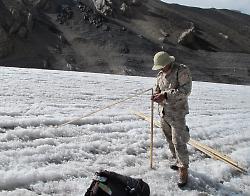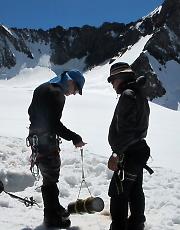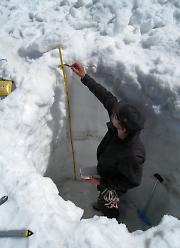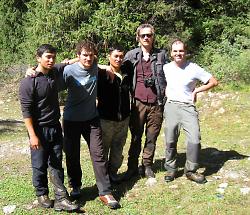Glacier monitoring in the Tian Shan Mountains continued
Following last year’s expeditions, a group of Kyrgyz, German and Swiss scientists continued the fieldwork on three selected glaciers in the Tian Shan mountains in Kyrgyzstan. The expedition team included researchers from the GFZ German Research Centre for Geosciences, Central Asian Institute of Applied Geosciences (CAIAG), University of Fribourg and the World Glacier Monitoring Service WGMS.

Fieldworks in August 2011
From August 8th to 22nd 2011 the group visited three glacier sites where measurements had been taken already during last year’s expedition: Golubina glacier in the Ala-Archa valley, glacier No. 354 in the Akshiirak massif and glacier No. 419 in the Suek range. In addition, Karabatkak glacier was visited and evaluated in view of the continuation of the existing mass balance measurements.
The ablation stakes, which had been installed in 2010, were read and partly re-installed. First results show an ongoing glacier ice melt for the period between July 2010 and August 2011. To conclude about a possible glacier retreat, a complete mass balance will be further evaluated.

In addition to the ablation measurements, snow accumulation measurements were carried out to determine the annual mass input of the investigated glaciers.
Finally, ice thickness profiles were measured using a ground penetrating radar. Those measurements provide useful information on spatial ice mass distribution which is needed for model parameterization. Maximum thickness values detected were in the range between 160 to 170 meters for all investigated glaciers.
In the frame of the CAWa project, the gathered data will be analyzed and integrated into a hydrological model for estimation of water availability in Central Asian catchments. The collected data will improve our understanding of glaciers as an important component within the hydrological system of Central Asia.
WGMS: Continuation of glacier monitoring is intended

Glacier monitoring has been coordinated at international level since the late 19th century. Today, standardized data on glacier distribution and changes are compiled and disseminated within the Gobal Terrestrial Network for Glaciers, which is run jointly by the World Glacier Monitoring Service (WGMS), the U.S. National Snow and Ice Data Center(NSIDC), and the Global Land Ice Measurements from Space (GLIMS) initiative.
In Kyrgyzstan, in-situ glacier monitoring has a long tradition. There are three glaciers with time series of several decades’ length until the collapse of the Soviet Union in the early 1990ies: Abramov, Golubin and Karabatkak glaciers.
The WGMS is encouraging the re-establishment of monitoring infrastructure and the continuation of glaciological measurements in the future. In collaboration with WGMS, the Swiss Government started a project called CATCOS to support such initiatives in Kyrgyzstan.
The measurements performed within the CAWa project are therefore highly welcomed and their continuation, in collaboration with CAIAG and GFZ, in the near future is intended.

Submitted by Katy Unger-Shayesteh on